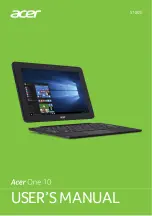
WinBook XL2 Low Power Measures
When you are running on battery power, your WinBook XL2 tracks battery
charge. When battery power gets low, the unit will provide warnings and
eventually take action to help preserve data.
When the WinBook XL2 estimates that the battery has only a few minutes
of battery power remaining (the actual time will vary with usage), the right
indicator on the hinge of the display panel will start to flash red. A system
buzzer provides an audible warning. (You can disable this buzzer in the
Setup utility—see Chapter Eight). You can also set Windows 98 to provide
low power warnings (see above).
When you receive the low power warnings, you should shut down your
system, suspend your system or connect to a power source. If you respond
immediately after receiving the warnings, you should have sufficient power
to shut down completely, including saving large files. Do not attempt to
restart your system until you have connected to the AC adapter or changed
or charged your battery.
A few minutes after these warnings, the system will suspend. You will not
be able to resume using the computer until you connect the system to a
power source or replace the battery with a charged battery (if you have a
spare). Once you provide power to the system, all data that had been held
in memory will be restored.
Standby and Suspend Modes
While both Standby mode and Suspend mode permit power savings, each
serves a different purpose. The Standby mode can shut down the screen
and put the hard disk into a less power-demanding mode (the exact action
of the Standby mode, as well as the default time for it to take effect are set
using the Setup program-see Chapter Eight). It is intended to lower power
consumption for short times. When you reactivate the computer, the system
is ready to go almost immediately. It is best for a short power-down when
you want to get back to work right away.
Chapter 3: Mobile Computing
3.9
If your WinBook XL2 is
unable to suspend to disk
(for example if your Save-
to-Disk partition is too small or
damaged), it will suspend to
RAM. When the unit is suspend-
ed to RAM, there will be a slow
trickle of power and the battery
could drain completely and data
could be lost.
When the unit is suspend-
ed to RAM, the power
management system can-
not gauge battery charge levels.
Since the Suspend-to-RAM mode
uses a trickle of battery power to
maintain the information in
RAM, the battery will slowly dis-
charge in this mode. As a result,
it is possible, if the unit remains
suspended until the battery is
completely discharged, for the
information in RAM to be lost. If
you will be suspending the sys-
tem for a long period, you
should use the Suspend-to-Disk
method.
Summary of Contents for XL2
Page 1: ...User s Manual for notebook computers ...
Page 6: ...Table of Contents 6 Table of Contents ...
Page 11: ...Preface v ...
Page 13: ...Chapter One Getting Started Chapter 1 Getting Started 1 1 ...
Page 40: ...Chapter Two Basic Computing Chapter 2 Basic Computing 2 1 ...
Page 60: ...Chapter Three Mobile Computing Chapter 3 Mobile Computing 3 1 ...
Page 80: ...Chapter Four Desktop Operation Chapter 4 Desktop Operation 4 1 ...
Page 98: ...Chapter 4 Desktop Operation 4 19 ...
Page 99: ...Chapter Five PC Cards PCMCIA Chapter 5 PC Cards PCMCIA 5 1 ...
Page 113: ...Chapter Six Video Settings Chapter 6 Video Settings 6 1 ...
Page 123: ...Chapter Seven Upgrading Chapter 7 Upgrading 7 1 ...
Page 135: ...7 13 Chapter 7 Upgrading ...
Page 160: ...Chapter Nine Troubleshooting Chapter 9 Troubleshooting 9 1 ...
Page 187: ...Glossary Glossary G 1 ...
Page 204: ...Index Index I 1 ...
Page 211: ...WinBook Corporation 2701 Charter Street Hilliard Ohio 43228 ...
















































